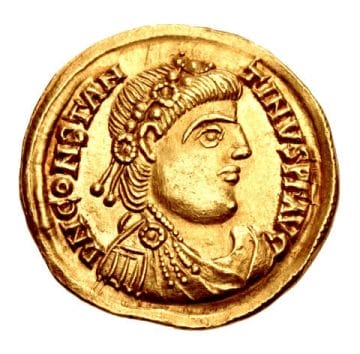Last Updated on November 27, 2023 by Vladimir Vulic
Life: AD ? – 411

- Name: Flavius Claudius Constantinus
- Birthdate unknown.
- Became emperor in AD 407.
- Died outside Ravenna, AD 411.
Nothing is known of Constantine III’s birth lace or earlier life.
He was a regular soldier in the garrison of Britain who somehow came to power during the tumultuous times following the mutiny against the rule of Honorius.
The mutiny against Honorius took place in AD 406, when the legions based in Britain hailed a certain Marcus emperor. Though he was soon assassinated. Next to accede to this break-away throne was an equally unknown Gratianus who in AD 407, after a four month reign, was also murdered.
The next man to be hailed Augustus in AD 407 was a ordinary soldier, who would come to be known as Constantine III. How he came to be chosen and elected is unknown.
His first act was to cross over to Gaul with most of the British garrison, which is traditionally seen as the evacuation of the British provinces by the Romans. The legions based in Gaul also switched their allegiance to him and so he gained control over most of Gaul and even parts of northern Spain. He established his capital at Arelate (Arles) in southern Gaul.
His legions then guarded the Rhine frontier with some success. Agreements were reached with some German tribes already settling in Gaul. Others tribes with whom such agreements could not be reached, were defeated in battle.
Honorius’ government in Ravenna Visigoth force commanded by their leader Sarus to dispose of the usurper and besieged Constantine III at Valentia (Valence).
But the siege was lifted when an army arrived led by Constantine II’s son Constans, who’d been elevated to the rank of Caesar by his father. Although Constans’ contribution was most likely more a symbolical leadership, the practical strategy was most likely left to Gerontius, Constantine III’s military chief.
For his efforts Constans was then elevated to be co-Augustus with his father.
Next Constantine III demanded that Honorius recognize him as Augustus, which the latter saw himself forced to do, in view of his desperately weakened position with the usurper in the west and Alaric in Italy.
In AD 409 Constantine III even held the office of consul as the colleague of Honorius.
The eastern emperor Theodosius II though refused to accept the usurper.
Constantine III now promised Honorius aide against Alaric, but clearly had the intention of conquering Italy for himself instead. Honorius’ own ‘Master of Horse’ might even have been part to such plans, but Honorius’ government arranged for his assassination.
Meanwhile Gerontius, was still based in Spain and had suffered setbacks against German tribes such as the Vandals, Sueves and Alans. Constantine III sent his son Constans to depose the general of his overall military command.
Gerontius though refused to resign and instead in AD 409 set up his own emperor, a certain Maximus who may have been his son. Gerontius then went on the attack, moved into Gaul where he killed Constans and laid siege to Constantine III in Arelate (Arles).
At this moment of weakness within the break-away western empire, in AD 411, Honorius’ new military commander Constantius (who was to become Constantius III in AD 421) intervened decisively and broke the siege, driving Gerontius back into Spain.
Constantius then laid siege to Arelate himself and captured the city. During the last hours of the city’s resistance, Constantine III resigned as emperor and had himself ordained as a priest, hoping this might save his life.
As the city fell, he was captured and sent back to Ravenna. Honorius’ though did not care much for what promises of safety his army commanders had given, for Constantine III had killed several cousins of his.
Hence Constantine III was taken outside the city of Ravenna and was put to death (AD 411).
Back in Spain, Gerontius died in a violent mutiny by his soldiers, as he was driven back into burning house. His puppet emperor Maximus, was deposed by the army and spent his life in exile in Spain.
But the break-away empire was not yet finished, as a Gallo-Roman noblemen named Jovinus came to power.
As Constantius had driven Athaulf and his Visigoths out of Italy, he struck a deal with the Visigoth to wage war on Jovinus for him.
Athaulf obliged, more so as his compatriot and enemy Sarus (who had already been the foe of Alaric) was siding with Jovinus.
Jovinus in AD 412 proclaimed his brother Sebastianus as co-Augustus.
Though it wasn’t to last. Athaulf defeated Sebastianus in battle and had him executed. Jovinus fled to Valentia (Valence) and there was besieged, captured and taken to Narbo (Narbonne) where Dardanus the praetorian prefect in Gaul who had remained loyal to Honorius throughout, had him executed.

Historian Franco Cavazzi dedicated hundreds of hours of his life to creating this website, roman-empire.net as a trove of educational material on this fascinating period of history. His work has been cited in a number of textbooks on the Roman Empire and mentioned on numerous publications such as the New York Times, PBS, The Guardian, and many more.
